Ficus capensis

|
|
Ficus capensis Common Names: African Mustard Tree, Cape Fig, Wild Fig Scientific
Classification Kingdom: Plantae Phylum: Tracheophyta Class: Magnoliopsida Order: Rosales Family: Moraceae Genus: Ficus Species: F. capensis Binomial Name: Ficus capensis Thunb. Synonyms: Ficus guineensis (Miq.) Stapf, Ficus ituriensis De Wild., Ficus mallotocarpa Warb., Ficus riparia (Miq.) A.Rich., Ficus thonningiana (Miq.) Miq. Morphological Description Ficus capensis is
a deciduous tree or shrub, growing 5–20 m tall with a trunk up to 150 cm in
diameter, occasionally buttressed. Key features include: · Bark: Smooth, grey when young, darkening to grey-brown with age · Leaves: Broadly oval to lance-shaped, 10–20 cm long, 5–13 cm wide,
dark green, smooth or slightly hairy, margins toothed or wavy, veins prominent
below · Fruits: Figs, 2–4 cm across, in clusters on branches up to 70 cm
long, orange-red when ripe, hairy, soft, edible but watery, containing many
seeds · Latex: White, milky, exuded when cut Distribution and Habitat Ficus capensis thrives
in: · Native Range: Southern and East Africa (South Africa, Zimbabwe,
Mozambique, Uganda, Ethiopia, Nigeria) · Habitat: Riverine forests, savannas, open woodlands, rocky slopes;
0–2,000 m altitude · Soil/Climate: Well-drained soils; tropical to subtropical, 800–2,000 mm
rainfall It often grows near
water sources, enhancing its ecological presence (Balslev & Friis, 2005). Ethnopharmacology Ficus capensis, commonly
known as the Cape fig, is extensively utilized in African traditional medicine
to address a variety of health conditions. Its leaves and roots are employed in
the treatment of ailments such as leukoderma, leprosy, wounds, edema,
respiratory disorders, diarrhea, sexually transmitted diseases, tuberculosis,
anemia, epilepsy, rickets, dysentery, male infertility, and gonorrhea.
Scientific studies have validated several traditional uses, demonstrating the
plant's anti-inflammatory, analgesic, antimicrobial, and antioxidant
properties. Traditional uses, with
some scientific support, include: · Skin Conditions: Latex applied to warts and ringworm in
Nigeria. · Dysentery/Diarrhea: Root decoction used in South Africa;
antidiarrheal effects. · Infertility: Leaf extract boosts penile function in Nigeria; increased
testosterone in rats (p<0.05 at 100 mg/kg), The extract inhibited ACE (IC50 = 52.17), AChE (IC50 = 172.60
μg/mL) and arginase (IC50 = 112.50 μg/mL) activities in a dose-dependent
pattern. Gallic acid, quercetin, caffeic acid, ellagic acid, rutin and
chlorogenic acid were the most abundant phenolic compounds identified in the
sample. Furthermore, extract scavenged NO (IC50 = 0.12 μg/mL) and OH (IC50 =
0.53 μg/mL) radicals, chelated Fe2 +
(IC50 = 0.16 μg/mL) and inhibited Fe2 +
lipid peroxidation (IC50 = 435.17 μg/mL) dose-dependently. Inhibition of ACE, AChE, arginase, Fe2 +
-induced lipid peroxidation as well as radical scavenging and Fe2 + -chelating
abilities could be some of the possible mechanisms by which F. capensis leaves
could be used in the treatment/management of erectile dysfunction (Akomolafe et
al., 2016). · Diabetes: Leaf tea in Nigeria; reduced blood glucose in rats (20% at
150 mg/kg) (Ezeigwe et al., 2020). · Wounds: Bark paste in Uganda; promotes healing in vitro (Shi et al.,
2018). Validation is ongoing;
caution is advised due to latex irritancy (PROTA, 2019). ⚠ Toxicity Profile: Latex irritates skin/eyes; ingestion may cause
nausea, vomiting (LD₅₀ ~1,800 mg/kg in rats) (Shi et al., 2018). Additional Information · Ecological Role: Figs feed birds (e.g., hornbills), bats,
and monkeys; pollinated by specific fig wasps (Balslev & Friis, 2005). · Cultural Use: Leaves used as vegetable in Nigerian soups (PROTA, 2019). · Conservation: Widespread but locally overharvested for medicine
(Cunningham, 2001). References
External Links More Pictures
|
|
| Compounds of Ficus capensis | |
| References |